Humminbird Matrix 97 User Manual

Table of Contents |
|
How Sonar Works |
1 |
DualBeam PLUS™ Sonar ................................................................................................................................ |
1 |
QuadraBeam™ Sonar (With Optional-Purchase QuadraBeam™ Transducer) ........................................ |
1 |
WideSide Sonar (With Optional-Purchase WideSide Transducer) .......................................................... |
2 |
How GPS and Cartography Work |
2 |
Multi-Media Card (MMC) ............................................................................................................................. |
3 |
What’s On the Sonar Display |
4 |
Views |
6 |
Sonar View ..................................................................................................................................................... |
7 |
Understanding Sonar History ...................................................................................................................... |
8 |
Real Time Sonar (RTS®) Window ................................................................................................................ |
8 |
Bottom Presentation .................................................................................................................................... |
9 |
Sonar Zoom View ........................................................................................................................................ |
10 |
200/83 kHz Split Sonar View .................................................................................................................... |
11 |
Big Digits View.............................................................................................................................................. |
11 |
Side Beam View ........................................................................................................................................... |
12 |
WideSide View ............................................................................................................................................. |
13 |
Bird's Eye View ............................................................................................................................................. |
14 |
Chart View .................................................................................................................................................... |
15 |
Combo View ................................................................................................................................................. |
15 |
View Orientation ......................................................................................................................................... |
16 |
Viewing Cartography |
16 |
Introduction to Navigation |
18 |
Waypoints, Routes and Tracks ................................................................................................................... |
18 |
Save, Edit or Delete a Waypoint ................................................................................................................ |
19 |
Navigate to a Waypoint or Position......................................................................................................... |
20 |
Add a Waypoint Target or Trolling Grid ................................................................................................... |
21 |
Save, Edit or Delete a Route ...................................................................................................................... |
22 |
Save or Clear a Current Track .................................................................................................................... |
23 |
Edit, Delete or Hide Saved Tracks ............................................................................................................. |
23 |
Key Functions |
24 |
POWER Key ................................................................................................................................................. |
24 |
LIGHT Key .................................................................................................................................................... |
24 |
VIEW Key .................................................................................................................................................... |
24 |
INFO Key ...................................................................................................................................................... |
24 |
MENU Key ................................................................................................................................................... |
25 |
4-WAY Cursor Control Key ........................................................................................................................ |
25 |
MARK Key .................................................................................................................................................... |
26 |
ii

Table of Contents |
|
GOTO Key ...................................................................................................................................................................... |
26 |
ZOOM (+/-) Key ............................................................................................................................................................ |
26 |
EXIT Key .......................................................................................................................................................................... |
26 |
VIEW PRESET Key.......................................................................................................................................................... |
26 |
Accessory Bus |
27 |
Powering Up the Unit |
27 |
The Menu System |
28 |
Start-Up Options Menu |
30 |
Normal Operation........................................................................................................................................................ |
30 |
Simulator ...................................................................................................................................................................... |
30 |
System Status ................................................................................................................................................................ |
31 |
PC Connect (with PC Connect Cable Only) .............................................................................................................. |
32 |
Sonar X-Press™ Menu (Sonar Views Only) |
33 |
WideSide View (WideSide Transducer: WideSide View Only) .......................................................................... |
33 |
Sensitivity ...................................................................................................................................................................... |
34 |
Upper Range (Advanced: Sonar, Split Sonar and Big Digits Views Only)........................................................ |
35 |
Lower Range ................................................................................................................................................................ |
36 |
Side Beam Range (WideSide Transducer: WideSide View Only) ...................................................................... |
37 |
Chart Speed .................................................................................................................................................................. |
37 |
Bottom View.................................................................................................................................................................. |
38 |
Navigation X-Press™ Menu (Navigation Views Only) |
39 |
Save Current Track ...................................................................................................................................................... |
39 |
Clear Current Track ...................................................................................................................................................... |
39 |
Save Current Route (Only When Navigating) ...................................................................................................... |
40 |
Skip Next Waypoint (Only When Navigating)...................................................................................................... |
40 |
Cancel Navigation (Only When Navigating).......................................................................................................... |
40 |
Remove Target (Only If Target is Active)................................................................................................................ |
41 |
Remove Grid (Only If Grid is Active) ........................................................................................................................ |
41 |
Sonar Window (Combo View Only).......................................................................................................................... |
41 |
Sonar Menu Tab |
42 |
Beam Select .................................................................................................................................................................. |
43 |
Fish ID+TM ........................................................................................................................................................................ |
44 |
Fish Sensitivity .............................................................................................................................................................. |
45 |
Real Time Sonar (RTS®) Window .............................................................................................................................. |
45 |
83 kHz Sensitivity (Advanced) .................................................................................................................................. |
45 |
455 kHz Balance (Advanced, with QuadraBeamTM Transducer)........................................................................ |
46 |
iii

Table of Contents |
|
WideSide Sensitivity (Advanced, with WideSide Transducer) .......................................................................... |
46 |
Depth Lines (Advanced) .............................................................................................................................................. |
47 |
Surface Clutter (Advanced) ........................................................................................................................................ |
48 |
Noise Filter (Advanced) .............................................................................................................................................. |
49 |
Max Depth (Advanced) .............................................................................................................................................. |
49 |
Water Type (Advanced) .............................................................................................................................................. |
50 |
Transducer Select ........................................................................................................................................................ |
50 |
Navigation Menu Tab |
51 |
Tracks .............................................................................................................................................................................. |
52 |
Waypoints ...................................................................................................................................................................... |
53 |
Routes.............................................................................................................................................................................. |
54 |
View Orientation .......................................................................................................................................................... |
54 |
Chart Detail Level.......................................................................................................................................................... |
55 |
Map Borders .................................................................................................................................................................. |
55 |
Lat-Lon Grid .................................................................................................................................................................... |
56 |
Spot Soundings ............................................................................................................................................................ |
56 |
Shaded Depth................................................................................................................................................................ |
56 |
North Reference............................................................................................................................................................ |
56 |
Grid Rotation.................................................................................................................................................................. |
57 |
Trackpoint Interval........................................................................................................................................................ |
57 |
Track Min Distance (Advanced) ................................................................................................................................ |
57 |
Map Datum (Advanced).............................................................................................................................................. |
58 |
Set Simulation Position (Advanced) ........................................................................................................................ |
58 |
Set Map Offset (Advanced) ........................................................................................................................................ |
58 |
Clear Map Offset (Advanced) .................................................................................................................................... |
59 |
Delete All Nav Data (Advanced)................................................................................................................................ |
59 |
Alarms Menu Tab |
60 |
Depth Alarm .................................................................................................................................................................. |
61 |
Fish ID Alarm .................................................................................................................................................................. |
61 |
Low Battery Alarm........................................................................................................................................................ |
62 |
Off Course Alarm .......................................................................................................................................................... |
62 |
Arrival Alarm.................................................................................................................................................................. |
63 |
Drift Alarm...................................................................................................................................................................... |
63 |
Alarm Tone .................................................................................................................................................................... |
63 |
Setup Menu Tab |
64 |
Units - Depth.................................................................................................................................................................. |
65 |
Units - Temp (International Only) ............................................................................................................................ |
65 |
Units - Distance ............................................................................................................................................................ |
65 |
Units - Speed.................................................................................................................................................................. |
66 |
iv

Table of Contents |
|
User Mode...................................................................................................................................................................... |
66 |
Language (International Only).................................................................................................................................. |
66 |
Triplog Reset ................................................................................................................................................................ |
67 |
Restore Defaults............................................................................................................................................................ |
67 |
Select Views (Advanced) ............................................................................................................................................ |
68 |
Select Readouts (Advanced, Sonar View Only) .................................................................................................... |
69 |
Depth Offset (Advanced)............................................................................................................................................ |
70 |
Temp Offset (Advanced) ............................................................................................................................................ |
70 |
Speed Calibration (Advanced, with Temp/Speed Only) .................................................................................... |
70 |
Local Time Zone (Advanced) ...................................................................................................................................... |
71 |
Daylight Savings Time (Advanced) .......................................................................................................................... |
71 |
Position Format (Advanced) ...................................................................................................................................... |
71 |
Time Format (Advanced, International Only) ........................................................................................................ |
72 |
Date Format (Advanced, International Only) ........................................................................................................ |
72 |
NMEA Output (Advanced).......................................................................................................................................... |
73 |
Sonar................................................................................................................................................................................ |
73 |
Accessories Menu Tab |
74 |
Troubleshooting |
75 |
Fishing System Doesn’t Power Up............................................................................................................................ |
75 |
Fishing System Defaults to Simulator with a Transducer Attached ................................................................ |
75 |
Display Problems .......................................................................................................................................................... |
76 |
Finding the Cause of Noise ........................................................................................................................................ |
77 |
Matrix Fishing System Accessories |
78 |
Specifications |
79 |
Notes |
80 |
Contact Humminbird |
82 |
NOTE: Entries in this Table of Contents which list (International Only) are only available on products sold outside of the US and Canada by our authorized International Distributors. To obtain a list of authorized International Distributors, please visit our website at www.humminbird.com or contact our Customer Resource Center at 1-800-633-1468 to locate the distributor nearest you.
NOTE: Entries in this Table of Contents which list (with PC Connect Cable Only) or (with OptionalPurchase QuadraBeamTM/WideSide Transducer) or (with Temp/Speed Only) require the purchase of separate accessories. You can visit our website at www.humminbird.com to order these accessories online or contact our Customer Resource Center at 1-800-633-1468.
v
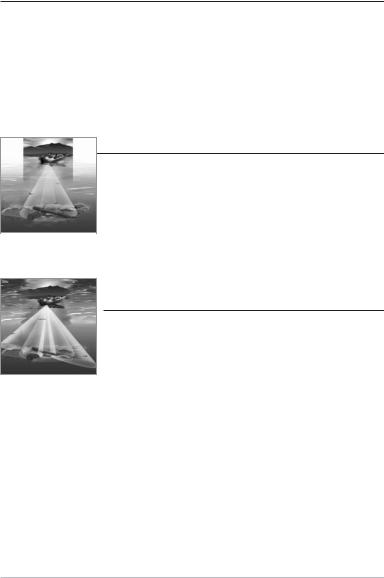
How Sonar Works
Sonar technology is based on sound waves. The Matrix Fishing System uses sonar to locate and define structure, bottom contour and composition, as well as depth directly below the transducer.
Your Matrix Fishing System sends a sound wave signal and determines distance by measuring the time between the transmission of the sound wave and when the sound wave is reflected off of an object; it then uses the reflected signal to interpret location, size, and composition of an object.
Sonar is very fast. A sound wave can travel from the surface to a depth of 240 ft (70 m) and back again in less than ¹⁄ of a second. It is unlikely that your boat can "outrun" this sonar signal.
DualBeam PLUS™ Sonar
Your Matrix 97 Fishing System is shipped with a 200/83 kHz DualBeam PLUSTM sonar system with a wide (60°) area of coverage. DualBeam PLUSTM sonar returns can be blended together, viewed separately or compared side-by-side. DualBeam PLUSTM is ideal for a wide range of conditions - from shallow to very deep water in both fresh and salt water. Depth capability is affected by such factors as boat speed, wave action, bottom hardness, water conditions and transducer installation.
QuadraBeam™ Sonar
(with Optional-Purchase QuadraBeamTM Transducer)
Your Matrix 97 Fishing System also supports QuadraBeam™ sonar with the purchase of an additional QuadraBeam™ transducer. QuadraBeam™ sonar provides an extremely wide 90° area of coverage. QuadraBeam™ starts with two 45° 455 kHz beams for a continuous 90° of uninterrupted side to side coverage to 160 feet. These Side Structure locating beams reveal fish and structure to the left and right of your boat near the bottom. For structure directly below your boat, Quadrabeam™ uses DualBeam PLUS™ technology.
1

WideSide Sonar
(with Optional-Purchase WideSide Transducer)
Your Matrix 97 Fishing System also supports WideSide sonar with the purchase of an additional WideSide transducer. The WideSide transducer is a specialized "side-looking" transducer that is extremely useful for bank fishing or looking for bait fish in open water. The WideSide transducer uses three different sonar elements that transmit signals to the left, right and straight down from your boat. The downward beam is 200 kHz with a 24° area of coverage. This beam maintains a continuous digital depth readout from the bottom directly beneath your boat. The side beams are 455 kHz with a 16° area of coverage. The side-looking elements can be used independently, or together to locate targets near the surface of the water on either side of your boat.
How GPS and Cartography Work
Your Matrix Fishing System uses GPS and sonar to determine your position, display it on a grid, and provide detailed underwater information. The Global Positioning System (GPS) is a satellite navigation system designed and maintained by the U.S. Department of Defense. GPS was originally intended for military use; however, civilians may also take advantage of its highly accurate position capabilities, typically within +/- 10 meters, depending on conditions. This means that 95% of the time, the GPS receiver will read a location within 10 meters of your actual position. Your GPS Receiver also uses information from WAAS (the Wide Area Augmentation System), EGNOS (the European Geostationary Navigation Overlay Service), and MSAS (the MTSAT Satellite Augmentation System) satellites if they are available in your area.
GPS uses a constellation of satellites that continually send radio signals to the earth. Your present position is determined by receiving signals from up to 12 satellites and measuring the distance from the satellites.
The GPS Receiver included with your Matrix Fishing System allows you to combine easy-to-use FishingGPS™ chartplotter and navigation capabilities with advanced fishfinding. The following GPS functionality is currently supported by the Matrix Fishing System when it is connected to the included GPS receiver:
•View current position
•View current track (breadcrumb trail)
•View precision speed and heading from your GPS receiver
•Save tracks, waypoints and routes
•Travel a route and navigate from one waypoint to the next.
2
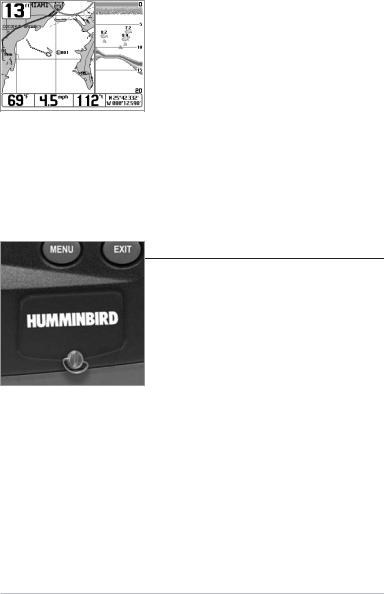
Your Matrix Fishing System supports Navionics® Gold Chart marine cartography and Navionics® HotMapsTM 2004 Gold for inland fishing.
NOTE: Your Matrix Fishing System does not support Navionics®
Classic Charts, only Navionics® Gold Charts and Navionics®
HotMapsTM 2004 Gold Charts.
Your unit also comes with a built-in World map with a more M97 Combo View Showing detailed map of North America (Domestic models) or a more Detailed Map detailed map of Europe and Southeast Asia, including
Australia and New Zealand (International models).
Your Matrix Fishing System uses the GPS Receiver to determine the position of the boat automatically, and uses the zoom level settings on a particular view to select the best chart to display. See Viewing Cartography for more information.
Multi-Media Card (MMC)
Your Matrix Fishing System also has a multi-media card (MMC) slot that is used to insert optional-purchase cards containing additional detailed maps. If you insert an MMC that contains a more detailed chart for a particular location, your Matrix Fishing System will retrieve that chart and display it automatically. Use the illustration to locate the position of the MMC slot cover, remove the MMC slot cover, and then insert the MMC into the slot. The label on the MMC
should face up. Press down on the card until it clicks into Multi-Media Card (MMC) Slot place, then replace the slot cover, making certain that the
gasket is present and positioned correctly before re-installing the cover, then replace and tighten the screw snugly - do NOT overtighten, as this will not improve water resistance, and may damage the cover.
3
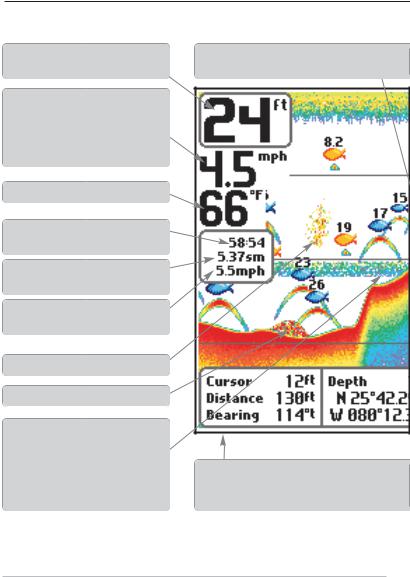
What’s On the Sonar Display
The Matrix Fishing System can display a variety of useful information about the area under and adjacent
Depth - water depth; can be set to alarm when the water becomes too shallow.
Timer - elapsed time with Temp/Speed Accessory or GPS Receiver.
Distance - distance traveled with Temp/Speed Accessory or GPS Receiver.
Average Speed - average speed reading with Temp/Speed Accessory or GPS Receiver.
Structure - where fish may be hiding.
Thermoclines - layers of water with different temperatures that appear at different depths and different times of the year. A thermocline typically appears as a continuous band of many gray levels moving across the display at the same depth.
Cursor - available in Freeze Frame and can be positioned and bottom depth below the cursor.
Cursor Dialog Box - indicates cursor depth on the display In addition, the Latitude and Longitude of the cursor position and the bearing to the cursor position. A waypoint
Temp/Speed or GPS Receiver) are available if either device is connected
4
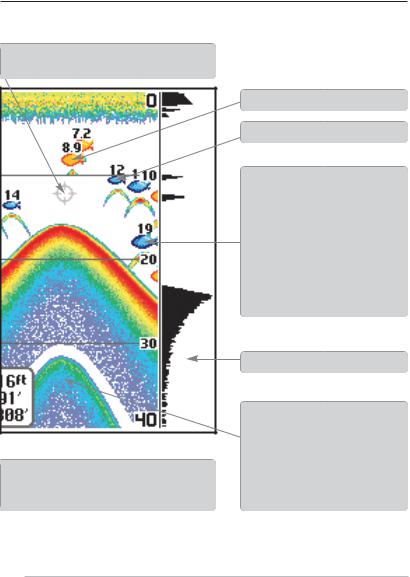
to your boat, including the following items:
in the Sonar View to provide depth of a sonar return
200 kHz Orange Fish Symbol
83 kHz Blue Fish Symbol
to the Matrix Fishing System. If both devices are connected, then
5
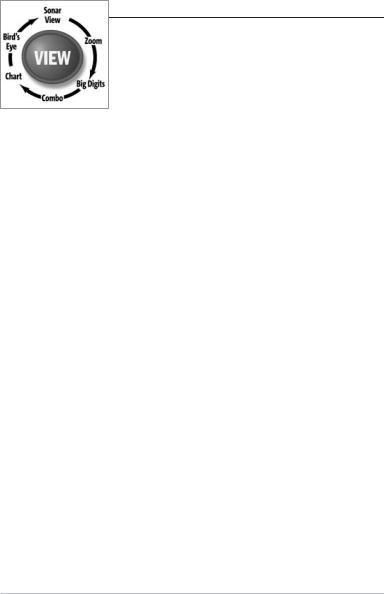
Views
The views available on your Matrix Fishing System are:
Sonar views: |
Navigation views: |
• Sonar View |
• Bird’s Eye View |
• Zoom View |
• Chart View |
• 200/83 kHz Split Sonar View |
• Combo View |
• Big Digits View |
|
• Side Beam View |
|
• WideSide View |
|
NOTE: Side Beam View and WideSide View require the purchase of the QuadraBeamTM transducer for the Side Beam View and the WideSide transducer for the WideSide View. You can visit our website at www.humminbird.com to order these accessories online or contact our Customer Resource Center at 1-800-633-1468.
Sonar View is the default view. When the VIEW key is pressed, the display cycles through the available views. When the EXIT key is pressed, the display cycles through the available views in reverse order. Any view can be hidden or displayed as part of the view rotation using Select View from the Advanced Setup Menu.
NOTE: When you change any menu settings that affect the sonar, the view will update immediately (i.e. you don’t have to exit the menu to apply the change to the screen).
6
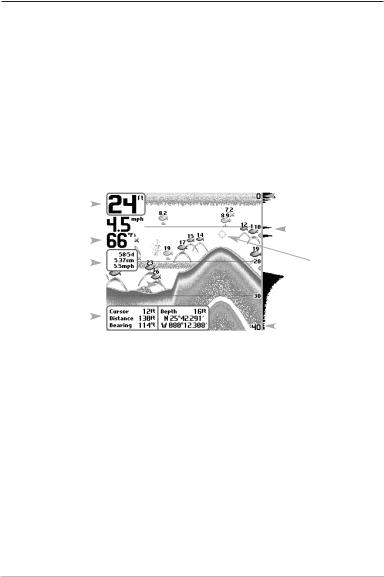
Sonar View
Sonar View presents a historical log of sonar returns. Depth is always displayed. Readouts for temperature and speed are automatically displayed if the appropriate accessory is connected. The most recent sonar returns are charted on the right side of the window; as new information is received, the older information is moved across the display to the left. A Digital Depth Readout is displayed in the upper left corner. A scale with Upper and Lower Depth Range readouts appears along the right edge of the Sonar View. The scale indicates the distance from the surface of the water to a depth range sufficient to show the bottom. Depth Range is automatically selected to keep the bottom visible on the display, although you can adjust it manually as well (see Sonar X-PressTM Menu). Six additional Digital Readouts display information from optional-purchase accessories. These information boxes can be customized to show only the information desired (see Setup Menu Tab,
Select Readouts).
|
|
|
|
|
Sonar View |
||||
Depth |
|
|
|
|
|
|
|
|
Upper Depth |
|
|
|
|
|
|
|
|
||
|
|
|
|
|
|
|
Range |
||
|
|
|
|
|
|
|
|
|
|
Temperature |
|
|
|
|
|
|
|
|
RTS® |
|
|
|
|
|
|
|
|
||
|
|
|
|
|
|
|
Window |
||
|
|
|
|
|
|||||
Triplog |
|
|
|
|
|
|
|
Cursor |
|
|
|
|
|
|
|||||
Sonar History |
|
|
|
|
|
|
|
|
|
|
|
|
|
|
|
|
|
|
|
Window |
|
|
|
|
|
|
|||
Cursor |
|
|
|
|
|
|
|
|
Lower Depth |
|
|
|
|
|
|
|
|||
Dialog Box |
|
|
|
|
|
||||
|
|
|
|
|
Range |
||||
|
|
|
|
|
|
|
|
|
|
NOTE: If the Depth number is flashing, it means that the unit is having trouble locating the bottom. This usually happens if the water is too deep, the transducer is out of the water, the boat is moving too fast, or for any other reason that the unit can’t accurately receive continuous data.
Freeze Frame - Pressing any arrow on the 4-WAY Cursor Control key will freeze the screen in the Sonar View and a cursor and cursor dialog box will be displayed on the screen. The cursor can be positioned on the display using the 4-WAY Cursor Control key to determine the depth of any sonar return. The RTS® Window continues to update in Freeze Frame. In addition, see the effects of menu setting changes with Instant Image Update. Pressing EXIT will exit Freeze Frame and the display will start to scroll. Freeze Frame is only available in the Sonar View.
7
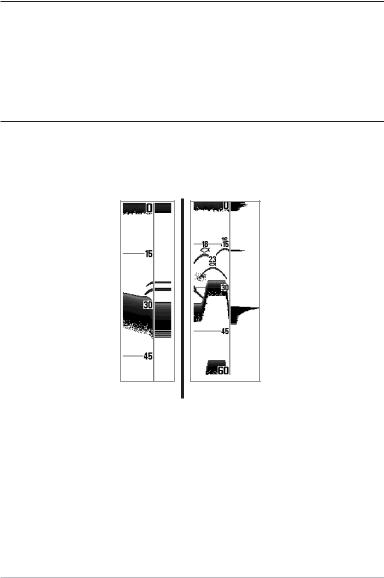
Understanding Sonar History
It is important to understand the significance of the Matrix Fishing System display. The display does NOT show a literal 3-dimensional representation of what is under the water. Each vertical band of data received by the control head and plotted on the display represents something that was detected by a sonar return at a particular time. As both the boat and the targets (fish) may be moving, the returns are only showing a particular segment of time when objects were detected, not exactly where those objects are in relation to other objects shown on the display.
Real Time Sonar (RTS®) Window
A Real Time Sonar (RTS®) Window appears on the right side of the display in the Sonar View only. The RTS® Window always updates at the fastest rate possible for depth conditions and shows only the returns from the bottom, structure and fish that are within the transducer beam. The RTS® Window plots the depth and intensity of a sonar return. (See Sonar Menu: RTS® Window) .
The Narrow RTS® Window indicates the sonar intensity throughtheuseofcolors. Red indicates a strong return and blue indicates a weak return. The depth of the sonar return is indicated by the vertical placement of the return on the display depth scale.
The Wide RTS® Window indicates the sonar intensity through the use of a bar graph. The length of the plotted return provides an indication of whether the return is weak or strong. The depth of the sonar return is indicated by the vertical placement of the return on the display depth scale.
8
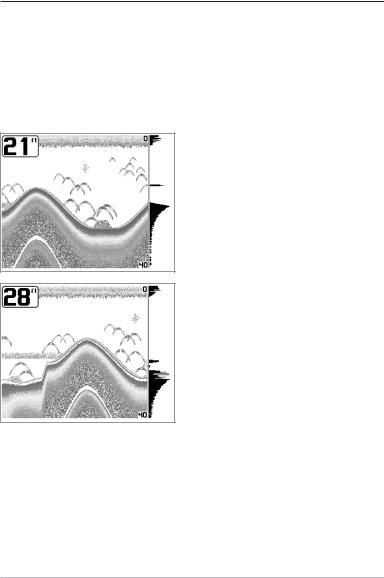
Bottom Presentation
As the boat moves, the unit charts the changes in depth on the display to create a profile of the Bottom Contour. The type of bottom can be determined from the return charted on the display. A Hard Bottom such as compacted sediment or flat rock appears as a thinner line across the display. A Soft Bottom such as mud or sand appears as a thicker line across the display. Rocky Bottoms have a broken, random appearance.
The sonar returns from the bottom, structure and fish can be represented as either Structure ID® or WhiteLine®. See Sonar X-PressTM Menu: Bottom View for details on how to set the bottom view.
Structure ID® represents weak returns in blue and strong returns in red.
WhiteLine® highlights the strongest sonar returns in white, resulting in a distinctive outline. This has the benefit of clearly defining the bottom on the display.
9
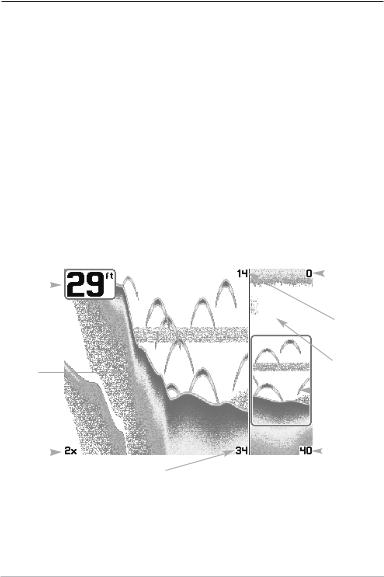
Sonar Zoom View
Sonar Zoom View increases the displayed resolution to separate sonar returns that are very close together, such as those caused by fish suspended close to the bottom or within structure. In Zoom View, the display is split to show a narrow slice of the full range view on the right and the zoomed view on the left. The full range view on the right also contains the Zoom Preview Box that shows what part of the full range view is shown in zoom view on the left; the Zoom Preview Box tracks the bottom in the full range view.
As the depth changes, the zoomed view updates automatically to display a magnified image of the bottom. The Zoom Preview Box shows where the zoomed view is in relation to the full range view. The Zoom Level, or magnification, is displayed in the lower left corner and can be changed to suit conditions (see Sonar X-PressTM Menu: Zoom Level). Upper and Lower Zoom Depth Range numbers indicate the depth of the water which is being viewed.
Digital depth is displayed in the upper left hand corner. The digital readouts in the Sonar Zoom View cannot be customized; therefore, information such as water temperature and voltage are unavailable in the Sonar Zoom View.
|
|
|
|
|
Sonar Zoom View |
|
|
|
|
|
|
|
|
|
|
|
|
|
|
|
|
|
|
|
|
|
|
|
|
|
|
|
|
|
|
|
|
|
Upper Depth |
|
|
|
|
|
|
|
|
|
|
|
|
|
|
||
|
|
Depth |
|
|
|
|
|
|
|
|
Range, Full |
|
|
|
|
|
|
||||||||||
|
|
|
|
|
|
|
|
|
|
|
Range View |
|
|
|
|
|
|
|
|
|
|
|
|
|
|
||
|
|
|
|
|
|
|
|
|
|
|
|
|
|
|
|
|
|
|
|
|
|
|
|
|
Upper Depth |
|
|
|
|
|
|
|
|
|
|
|
|
|
Range, Zoom |
|
|
|
|
|
|
|
|
|
|
|
|
|
View |
|
|
|
|
|
|
|
|
|
|
|
|
|
|
|
|
|
|
|
|
|
|
|
|
|
|
|
|
|
|
|
|
|
|
|
|
|
|
|
|
|
Full Range |
|
|
|
|
|
|
|
|
|
|
|
View |
|
|
||
|
Zoomed |
|
|
|
|
|
|
|
|
|
|||
|
|
View |
|
|
|
|
|
|
|
|
|
|
|
|
|
|
|
|
|
|
|
|
|||||
|
|
|
|
|
|
Zoom |
|
||||||
|
|
|
|
|
|
|
|
|
|
|
|
||
|
|
|
|
|
|
|
|
|
|
|
Preview Box |
|
|
|
|
|
|
|
|
|
|
|
|
|
|
|
|
|
|
|
|
|
|
|
|
|
|
|
|
|
|
Zoom Level |
|
|
|
|
|
|
|
|
Lower Depth |
|
|||
|
|
|
|
|
|
|
|
|
|||||
|
|
|
|
|
Lower Depth Range, |
|
|
|
|
Range, Full |
|
||
|
|
|
|
|
|
|
|
|
|
||||
|
|
|
|
|
|
|
|
|
Range View |
|
|||
|
|
|
|
|
Zoom View |
|
|
|
|
|
|||
|
|
|
|
|
|
|
|
|
|
|
|
||
|
|
|
|
|
|
|
|
|
|
|
|
||
10
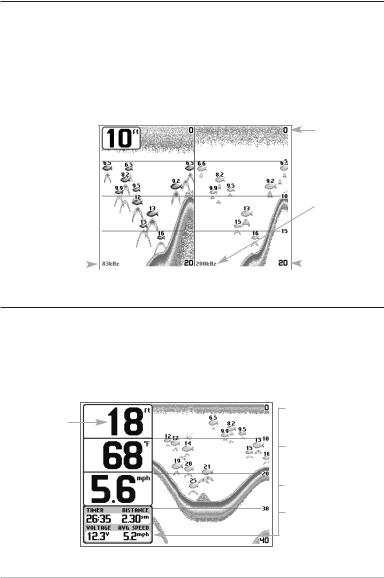
200/83 kHz Split Sonar View
Split Sonar View displays sonar returns from the 83 kHz wide beam on the left side of the screen and displays sonar returns from the 200 kHz narrow beam on the right side of the screen. Depth is always displayed in the upper left hand corner. You can use the Split Sonar View to make side by side comparisons between the sonar returns from the 83 kHz wide beam and the 200 kHz narrow beam.
The digital readouts in the Split Sonar View cannot be customized; therefore, information such as water temperature and voltage are unavailable in the Split Sonar View.
200/83 kHz Split Sonar View
Upper
Depth  Depth
Depth
Range
|
|
|
|
|
|
200 kHz |
|
|
|
|
|
|
Sonar |
|
|
|
|
|
|
History |
83 kHz |
|
|
|
Window |
||
Sonar History |
|
|
|
|
||
Window |
|
|
|
|
|
Lower Depth |
|
|
|
|
|
||
|
|
|
|
|
|
Range |
Big Digits View
Big Digits View provides digital data in a large, easy-to-see format. Depth is always displayed. Readouts for temperature, speed and Triplog information are displayed automatically if the appropriate accessory is connected to the Matrix Fishing System. The Triplog shows distance traveled, average speed, and time elapsed since the Triplog was last reset. The digital readouts in the Big Digits View cannot be customized.
Big Digits View
Depth
Temperature 
Speed 
Timer shows the time elapsed since Triplog was last reset
Distance is the distance traveled since the Triplog was last reset
Voltage - the battery voltage.
Average Speed shows the speed since the Triplog was last reset
11
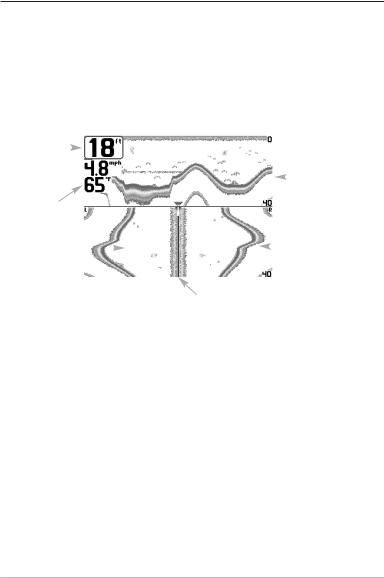
Side Beam View
Side Beam View is only available if you have connected a QuadraBeamTM transducer accessory and when Transducer Select is set to QuadraBeam™ (see Sonar Menu Tab: Transducer Select). The QuadraBeam™ transducer requires a separate purchase. This view shows sonar information from both the left and right 90° 455 kHz beams and the 200 kHz down-looking beam in one view. The top portion of the display presents a historical log of sonar returns from the 200 kHz down-looking sonar. The bottom portion of the display presents a historical log of sonar returns from the 455 kHz rightand left-looking sonar. New information appears at the top, and scrolls down the display.
|
|
|
|
|
Side Beam View |
||||
Depth |
|
|
|
|
|
|
|
|
200 kHz Sonar |
|
|
|
|
|
|
|
|
||
|
|
|
|
|
|
|
|||
|
|
|
|
|
|
|
|
|
|
|
|
|
|
|
|
|
|
|
|
|
|
|
|
|
|
|
|
|
History Window |
Temperature |
|
|
|
|
|
|
|||
Left Side 455 kHz |
|
|
|
|
|
|
Right Side 455 kHz |
||
|
|
|
|
|
|
||||
Sonar History |
|
|
|
|
|
Sonar History |
|||
Window |
|
|
|
|
|
Window |
|||
|
|
|
|
|
|
|
|
|
|
|
|
|
|
|
Water Surface Line for 455 kHz |
||||
|
|
|
|
|
Sonar History Windows |
||||
The sonar information from the side-looking beams reveals bottom contour, structure and fish similar to the down-looking beam, but the area covered is to the left and right of the area shown in the downlooking portion, so you actually see more of the bottom. The distance covered by the right and left 90° beams is based on the depth setting for the down-looking beam, up to a maximum of 160 feet.
12
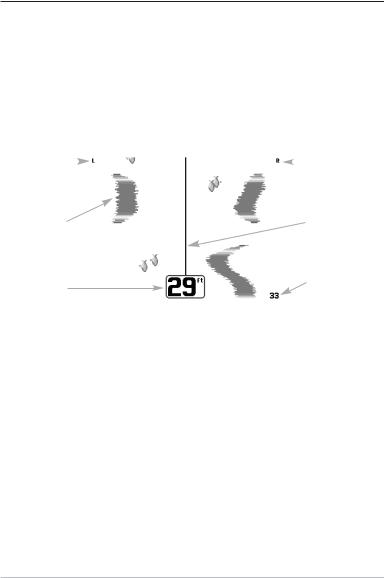
WideSide View
WideSide View is only available if you have connected a WideSide transducer accessory and when Transducer Select is set to WideSide (see Sonar Menu Tab: Transducer Select). The WideSide transducer requires a separate purchase. The WideSide View displays information from the 455 kHz SideView transducer. Three views are available: Left, Right and Both. The default view is Both. Information from both the left and right beams are displayed simultaneously. The depth of the water beneath the boat is always displayed. A bottom contour may be present while bank fishing or fishing river channels. When fishing in the open water, a bottom contour will not be present, and only sonar returns from either debris or fish will be displayed.
|
|
|
WideSide View |
|||
Left Side View |
|
|
|
|
|
Right Side View |
|
|
|
|
|
||
Bank Contour |
|
|
|
Water |
||
|
|
|
|
|
|
Surface Line |
Depth |
|
|
|
Side Beam |
||
|
|
|
Depth Range |
|||
|
|
|
|
|
|
|
|
|
|
|
|
|
|
13
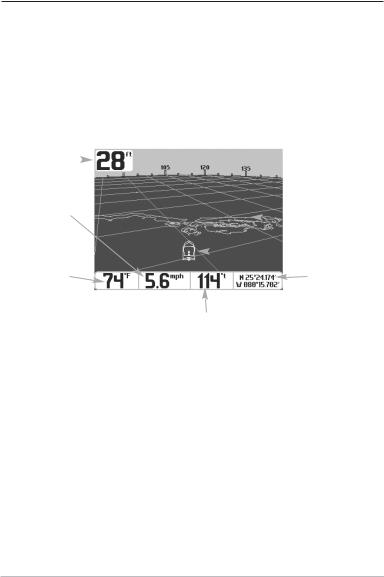
Bird’s Eye View
Bird's Eye View - This view shows a 3-D, perspective view of the track and the chart’s land contour from a pointaboveandbehindtheboat(theeyepoint).Astheboatturns,theeyepointmovestofollowtheboat.
Whenyoupressthe4-WAYCursorkeyintheBird’sEyeView,thepositionoftheeyepointwillshift.Thisallows youtomoveandturntheeyepointsothatyoucanlookofftothesides,orevenbehindtheboat.Pressingthe RIGHTorLEFTarrowkeysonthe4-WAYCursorkeyturnstheeyepointrightorleft,whilepressingtheUParrow key moves the eye point forward, and pressing the DOWN arrow key moves the eye point backward.
Pressing the EXIT key moves the eye point back to its original position behind and above the boat.
|
|
|
Bird’s Eye View |
||||
Depth |
|
|
|
|
|
|
|
|
|
|
|
|
|
||
Speed of Boat |
|
|
|
|
Land Contours |
||
|
|
|
|
|
|
|
|
Water Surface |
|
|
|
|
Boat Icon |
||
|
|
|
|
||||
|
|
|
|
Latitude and |
|||
Temperature |
|
|
|
|
Longitude |
||
|
|
|
|
|
|
|
Position of Boat |
|
|
|
Bearing of Boat with Respect to North Reference |
||||
14
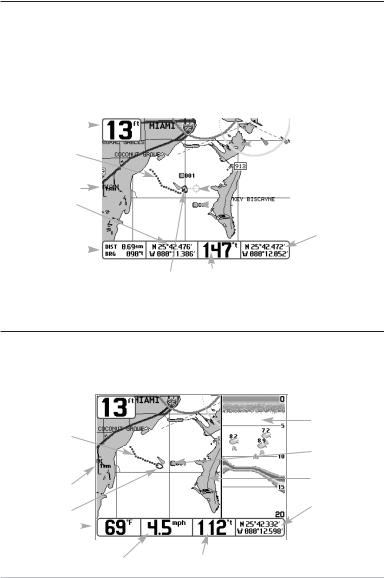
Chart View
Chart View - This view shows cartography from the built-in UniMap or an optional MMC map for the area surrounding your current position. The current track (also known as the position history or breadcrumb trail) showing where the boat has been, along with saved tracks, waypoints, and the current route (when navigating), are overlaid on the chart. You can use the 4-WAY Cursor Control key to shift/pan the chart to another area. You can use the ZOOM (+/-) keys to zoom in and out. You can use the INFO key to get information on the chart objects near the cursor.
|
|
|
|
|
|
|
Chart View with Active Cursor |
|||||||
|
|
|
Depth |
|
|
|
|
|
|
|
|
|
|
|
|
|
|
|
|
|
|
|
|
|
|
||||
|
|
|
Track |
|
|
|
|
|
|
|
|
|
|
|
|
|
|
|
|
|
|
|
|
|
|
|
|
|
|
|
|
|
|
|
|
|
|
|
|
|
|
Cartography |
||
|
|
|
|
|
|
|
|
|
||||||
|
(Breadcrumb |
|
|
|
|
|
|
|
|
|
|
|
||
|
|
|
|
|
|
|
|
|
|
|
|
|||
|
|
|
Trail) |
|
|
|
|
|
|
|
|
|
|
|
|
|
|
|
|
|
|
|
|
|
|
|
|
|
|
|
|
|
|
|
|
|
|
|
|
|
|
|
|
|
|
|
Map Scale |
|
|
|
|
|
|
|
|
|
Active Cursor |
|
|
|
|
|
|
|
|
|
|
|
||||||
|
|
|
|
|
|
|
|
|
|
|
|
|
|
|
|
|
|
|
|
|
|
|
|
|
|
|
|
||
|
|
|
|
|
|
|
|
|
|
|
|
|
|
|
|
|
|
|
|
|
|
|
|
|
|
|
|
Waypoint |
|
|
Latitude and |
|
|
|
|
|
|
|
|
|
||||
|
|
Longitude |
|
|
|
|
|
|
|
|
|
|
|
|
|
|
|
|
|
|
|
|
|
|
|
|
|
||
Position of Cursor |
|
|
|
|
|
|
|
|
|
|
|
|||
|
|
|
|
|
|
|
|
|
Latitude and |
|
||||
|
|
|
|
|
|
|
|
|
|
|
|
|
|
|
|
|
|
|
|
|
|
|
|
|
|
|
|
||
|
|
|
|
|
|
|
|
|
|
|
|
|
Longitude |
|
|
Distance to |
|
|
|
|
|
|
|
|
|
||||
|
|
|
|
|
|
|
|
|
|
Position of Boat |
|
|||
|
|
the Cursor |
|
|
|
|
|
|
|
|
|
|
||
|
|
|
|
|
|
|
|
|
|
|
|
|
||
|
and Bearing |
|
|
|
Boat Icon |
Bearing of Boat with Respect to |
|
|
||||||
|
|
|
|
|
||||||||||
|
|
to Cursor |
|
|
|
|
North Reference |
|||||||
|
|
|
|
|
|
|
|
|
|
|
|
|
|
|
Combo View
Combo View - This view is displayed as a split screen, with Chart View on the left and Sonar View on the right side of the screen. The width of the sonar window can be changed.
Combo View
Depth 
Sonar Window
Track
(Breadcrumb
Waypoint
Trail)
Cartography
Map Scale
|
Boat Icon |
|
|
|
|
|
Latitude and |
|
|
|
|
Longitude |
|||||
|
|
|
|
|
|
|
||
|
|
|
|
|
|
|
||
Water Surface |
|
|
|
|
Position of Boat |
|||
|
|
|||||||
Temperature |
|
|
|
|
|
|
||
|
|
|
|
|
||||
|
|
|
|
|
|
|
|
|
|
|
|
|
|
|
|
||
|
|
|
|
Speed of Boat |
|
Bearing of Boat with Respect to North Reference |
|
|
|
|
|
|
|
|
|
|
|
15
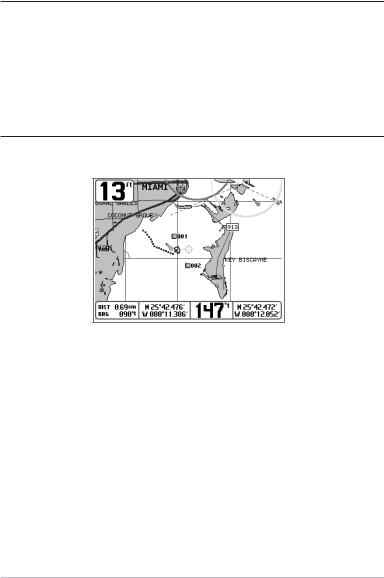
View Orientation
Both Chart and Combo views allow you to choose the orientation of the view. When North-Up orientation is selected, True North is shown at the top of the display. In other words, objects located to the north of the boat are drawn above the boat. When Course-Up orientation is selected, the direction of motion of the boat is shown at the top of the display. In other words, objects ahead of the boat are drawn above the boat. In both orientations, the view pans automatically, so that the boat is always centered on the display. When the boat is stationary, it is drawn as a circle. When the boat is in motion, it takes on a boat shape, pointed in the direction of motion (always Up in the Course-Up orientation).
Viewing Cartography
In the Chart or Combo Views, there are several cartography-related functions that you can access using various keys.
Chart View with Cursor Present
Panning: Use the 4-WAY Cursor keys to move the chart around on the display in the direction of the key being pressed. When you do this, a bullseye cursor is drawn at the center of the screen and is linked to the boat by a yellow line, even if the boat is off the screen. At the same time, the temperature and speed boxes in the lower left corner are replaced with the distance and bearing from the boat to the cursor position and the latitude/longitude coordinates of the cursor.
Zooming: Use the Plus (+) key to Zoom In and the Minus (-) key to Zoom Out showing the cartography at different scales. The scale is indicated on the left side of the display. If you zoom in beyond the available chart data, the display will go into Overzoom mode whereby the last available chart data is amplified to reflect the scale selected. If you zoom in so far that no cartography is available, a lat/long grid will be drawn instead.
Chart Info: Use the INFO key to get detailed information about the chart. If the cursor is active, you will see information about the chart objects located near the cursor. If the cursor is not active, the Chart Info menu will appear. You can select the nearest port, the nearest tide station, or the nearest current station to see information about any of these objects.
16

NOTE: The built-in UniMapTM does not contain any Port, Tide or Current information. This information is only available from optional-purchase MMC cards.
Nearest Port: The position and services information for the nearest port to your present position will be displayed. Press the EXIT key to remove the information box and the cursor bull’s eye will be centered over the port position. The cursor information boxes at the bottom of the display will indicate the distance and bearing to the port from your present position.
Nearest Tide Station: Tide information for the nearest tide station to your present position will be displayed. This includes the position of the station and the times of the high and low tides for today’s date. A tide graph is also displayed showing the rise and fall of the tides for the 24 hour time period encompassing the date. You can change the date to look at tide information before or after the date displayed by pressing the LEFT or RIGHT cursor key respectively. Press the EXIT key to remove the information box and the cursor bull’s eye will be centered over the tide station position. The cursor information boxes at the bottom of the display will indicate the distance and bearing to the tide station from your present position.
Nearest Current Station: Current information for the nearest current station to your present position will be displayed. This includes the position of the station and the current changes for today. Two graphs are also presented that show the time, direction and flow speed of the current changes for the 24 hour time period of today’s date. You can change the date to look at current information before or after the date displayed by pressing the LEFT or RIGHT cursor key respectively. Press the EXIT key to remove the information box and the cursor bull’s eye will be centered over the current station position. The cursor information boxes at the bottom of the display will indicate the distance and bearing to the current station from your present position.
17
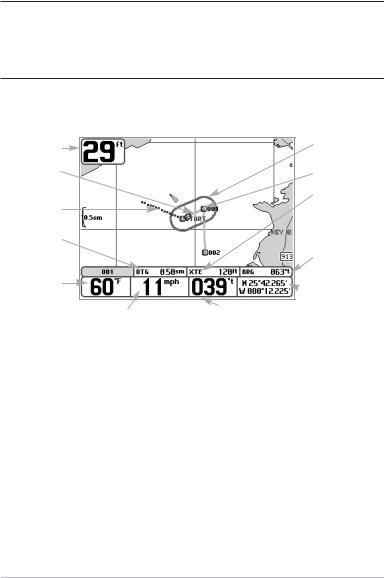
Introduction to Navigation
Use the Matrix Fishing System to establish waypoints at areas of interest and to navigate to those waypoints via a saveable route (representing the shortest intended distance between waypoints). You can also view and save tracks, which represent the actual path of the boat.
Waypoints, Routes and Tracks
Waypoints are stored positions that allow you to mark areas of interest or navigation points. Your Matrix Fishing System can store up to 750 waypoints.
Waypoints, Routes and Tracks
Depth |
Route |
Track |
DTG: Distance |
to Go to |
Waypoint |
Water Surface |
Temperature |
Speed of Boat
Bearing of Boat with Respect to North Reference
Off Course
Alarm Limits
Waypoint
XTE: Cross Track
Error. Distance of
Boat from Route
BRG: Bearing to
Waypoint
 Latitude and
Latitude and
Longitude
Position of Boat
Routes link two or more waypoints together to create a path for navigation, and are used in trip planning. You can link individual waypoints together by using the GOTO key. A route represents your intended navigation and shows the shortest path from each waypoint to the next. As you travel a route, staying on the route line is the most efficient way to get to your destination, although you should always look out for obstacles not shown on the chart. Your Matrix Fishing System can store up to 10 routes that can each contain up to 20 waypoints.
Tracks consist of detailed position history, and are displayed as a breadcrumb trail of trackpoints. The Current Track shows the position history since the unit was powered up (maximum of 2000 trackpoints displayed). You can clear the Current Track or save it at any time. Your Matrix Fishing System can store up to 10 saved tracks, each containing 2000 trackpoints. The current track represents your actual path so far.
18

Save, Edit, or Delete a Waypoint
Save your current position as a waypoint: On any view, press the MARK key to save the current position of the boat as a waypoint.
Save the cursor position as a waypoint: On the Chart or Combo view, use the Cursor key to designate the position you want to save as a waypoint. Then press the MARK key to save the marked position as a waypoint.
Save a position from the sonar history: On the Sonar view, use the Cursor key to point to a feature in the sonar history (also called the Sonar Saver feature). Press the MARK key to create a waypoint at the location where that sonar reading was taken. The new waypoint will also record the depth at that location.
NOTE: When you save a waypoint by any of these methods, a numerical waypoint name is automatically assigned. You can edit the waypoint information later to give it a different name and select an icon to represent it (see Waypoint submenu on the Navigation Main Menu Tab).
Display the Waypoints Submenu: From any view, press the MENU key twice to display the Main Menu System, then use the RIGHT Cursor key to select the Navigation tab. Select Waypoints and press the RIGHT Cursor key to display the Waypoints submenu.
Program a specific position as a waypoint: To create a waypoint that is NOT your current position, from the Waypoints submenu, select the Create option and press the RIGHT Cursor key. Use the Cursor keys to program a waypoint name, latitude, longitude, and icon before selecting Save.
Edit a waypoint: From the Waypoints submenu, select Edit and press the RIGHT Cursor key to display a list of saved waypoints. Select the waypoint you want to edit and press the RIGHT Cursor key. Use the 4-WAY Cursor Control key to move from field to field, and the UP and DOWN Cursor keys to changes values once you are in a field. In the Waypoint Name, Latitude and Longitude fields, use the UP and DOWN Cursor keys to change the letter or number. All upper and lower case letters are available, as well as digits 0-9 and some punctuation characters. In the Waypoint Icon field, use the UP and DOWN Cursor keys to change the icon used to represent the waypoint on the Combo and Chart Views. You can exit these fields with the LEFT and RIGHT Cursor keys or by pressing the EXIT key. Select Save and press the RIGHT Cursor key to save your changes.
To make it easier to select a waypoint, select Sort By and press the RIGHT or LEFT Cursor keys to select a sort order:
•Name shows the waypoints alphabetically
•Time shows the most recently-created waypoint first
•Distance shows the closest waypoint first.
19

Delete a waypoint: From the Waypoints submenu, select Delete and press the RIGHT Cursor key to display a list of waypoints. Select the waypoint you want to delete, then press the RIGHT Cursor key. You will be asked to confirm deletion before the waypoint is actually deleted.
Navigate to a Waypoint or Position
Navigate to the cursor position: From the Chart or Combo view, use the Cursor key to select a position or waypoint to which you want to navigate. Press the GOTO key. Navigation will begin immediately.
Navigate to a specified waypoint: Press the GOTO key, then choose the waypoint to which you would like to navigate from the waypoint list and press the RIGHT Cursor key to select it.
NOTE: By repeating the previous instructions, you can add more waypoints to create a longer multisegment route.
Skipping a waypoint: From the Navigation X-PressTM menu, select Skip Next Waypoint and press the RIGHT Cursor key. If there is not another waypoint to skip to, navigation will be cancelled.
Cancel navigation: From the Navigation X-PressTM menu, select Cancel Navigation and press the RIGHT Cursor key. Canceling navigation removes the route and any waypoints created using the GOTO key, but does not remove any saved routes from memory. You will be prompted to save the current route when you cancel navigation.
20
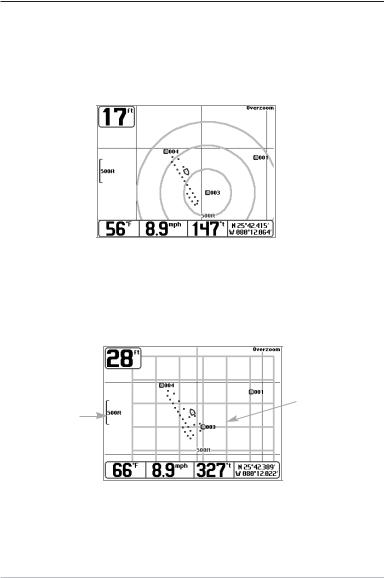
Add a Waypoint Target or Trolling Grid
Add or Remove a Waypoint Target: From the Waypoints submenu, select Target and press the RIGHT Cursor key to display a list of waypoints. Select the waypoint you want to target. A target consisting of concentric circles centered on the selected waypoint will appear on all of the navigation views; the target shows various distance ranges from the targeted waypoint. To remove the target, choose Remove Target from the Navigation X-Press™ menu.
Chart View with Target
Map Scale 
 Waypoint Target
Waypoint Target
Add or Remove a Trolling Grid: From the Waypoints submenu, select Grid and press the RIGHT Cursor key to display a list of waypoints. Select the waypoint to which you want to add the grid. The trolling grid will appear on all of the navigation views, and can be used as a guide when trolling around a waypoint. The grid can be rotated to any desired heading using Grid Rotation from the Navigation Main menu. To remove the trolling grid, choose Remove Grid from the Navigation X-Press™ menu.
Chart View with Grid
Waypoint
Trolling Grid
Map Scale
NOTE: Only one waypoint can have either a target or a grid at one time. If you apply a target or a grid to a new waypoint, the original waypoint will lose its target or grid.
NOTE: The spacing of the rings on the waypoint target and the spacing of the grid lines on the trolling grid is the same as the length of the scale bar on the left edge of the display. Zooming in or out will decrease or increase the spacing, respectively.
21

Save, Edit or Delete a Route
Save the current route: While you are navigating, the current route can be saved. From the Navigation X-PressTM menu, select Save Current Route and press the RIGHT Cursor key. Navigation will continue.
Display the Routes submenu: From any view, press the MENU key twice to display the Main Menu System, then use the RIGHT Cursor key to select the Navigation tab. Select Routes and press the RIGHT Cursor key to display the Routes submenu.
Create a route: From the Routes submenu, select Create and press the RIGHT Cursor key. A Route Edit screen will be displayed with an empty route. You can name the route, add waypoints to the route from the list of all waypoints, and order the waypoints in the route using the Cursor keys.
Edit a saved route: From the Routes submenu, select Edit and press the RIGHT Cursor key. A Route Edit screen will be displayed. Select the route you wish to edit and press the RIGHT Cursor key. Rename the route or change, delete or re-order the waypoints used in the route.
Delete a saved route: From the Routes submenu, select Delete and press the RIGHT Cursor key. Select the route you wish to delete and press the RIGHT Cursor key. You will be asked to confirm your choice by pressing the RIGHT Cursor key again before the route is deleted.
Travel a saved route: From the Routes submenu, select Travel and press the RIGHT Cursor key. A list of saved routes will appear. Select the route you wish to travel and press the RIGHT Cursor key to make this route the current route and begin navigation. You may also travel the route in either forward or reverse order.
Route Info: From the Routes submenu, select Info and press the RIGHT Cursor key. A list of saved routes will appear. Select the route for which you want information, and press the RIGHT Cursor key. The list of waypoints in the route will be shown, with the distance and bearing from each waypoint to the next, as well as the distance and bearing from the current position to the first waypoint in the route.
22

Save or Clear a Current Track
Save the current track: From the Navigation X-PressTM menu, select Save Current Track and press the RIGHT Cursor key. The track will remain on the display, but will change from black to gray. To remove the track completely from the display, see Edit, Delete or Hide Saved Tracks.
NOTE: When you save a track, a name is automatically assigned. The track name consists of a date/time stamp, but can be re-named later (see Edit a Saved Track).
Clear the current track: From the Navigation X-PressTM menu, select Clear Current Track and press the RIGHT Cursor key. The track will be removed from the display and discarded.
Edit, Delete or Hide Saved Tracks
Display the Tracks Submenu: From any view, press the MENU key twice to display the Main Menu System, then use the RIGHT Cursor key to select the Navigation tab. Select Tracks and press the RIGHT Cursor key to display the Tracks submenu.
Edit a saved track: From the Tracks submenu, select Edit and press the RIGHT Cursor key to display the list of saved tracks. Select the track you want to edit and press the RIGHT Cursor key. When the Edit Track dialog box appears, use the Cursor keys to move between fields. In the Track Name field, the UP and DOWN Cursor keys change the letter or number. All upper and lower case letters are available, as well as digits 0-9 and some punctuation characters. You can exit the Track Name field with the LEFT and RIGHT Cursor keys or by pressing the EXIT key. Select Save and press the RIGHT Cursor key to save your changes.
Delete a saved track: From the Tracks submenu, select Delete and press the RIGHT Cursor key to display the list of saved tracks. Select the track you want to delete and press the RIGHT Cursor key. You will be asked to confirm deletion before the track is actually deleted.
Hide or display a saved track: From the Tracks submenu, select Visibility and press the RIGHT Cursor key to display the list of saved tracks. Select the track you want to hide or display and use the Cursor keys to select Hidden or Visible. Press the EXIT key to return to the Tracks submenu.
23
